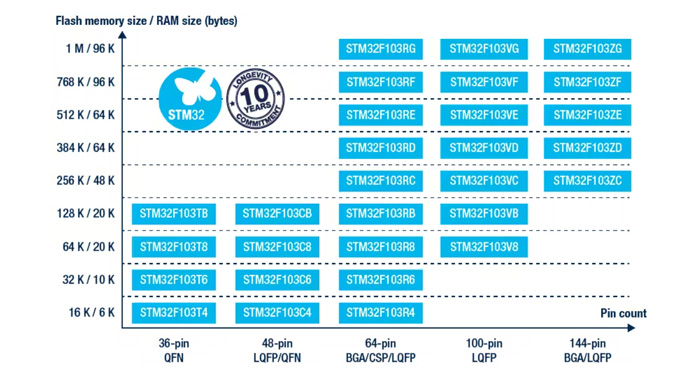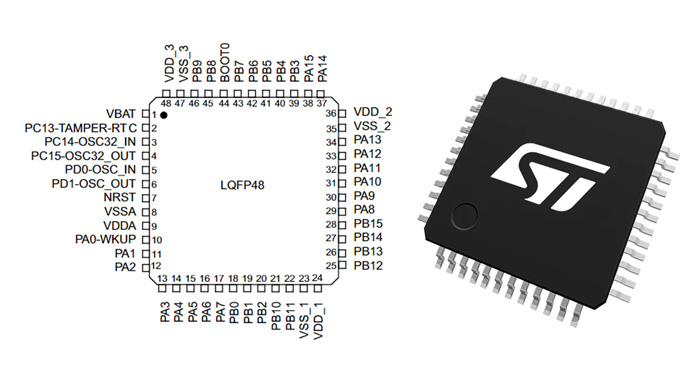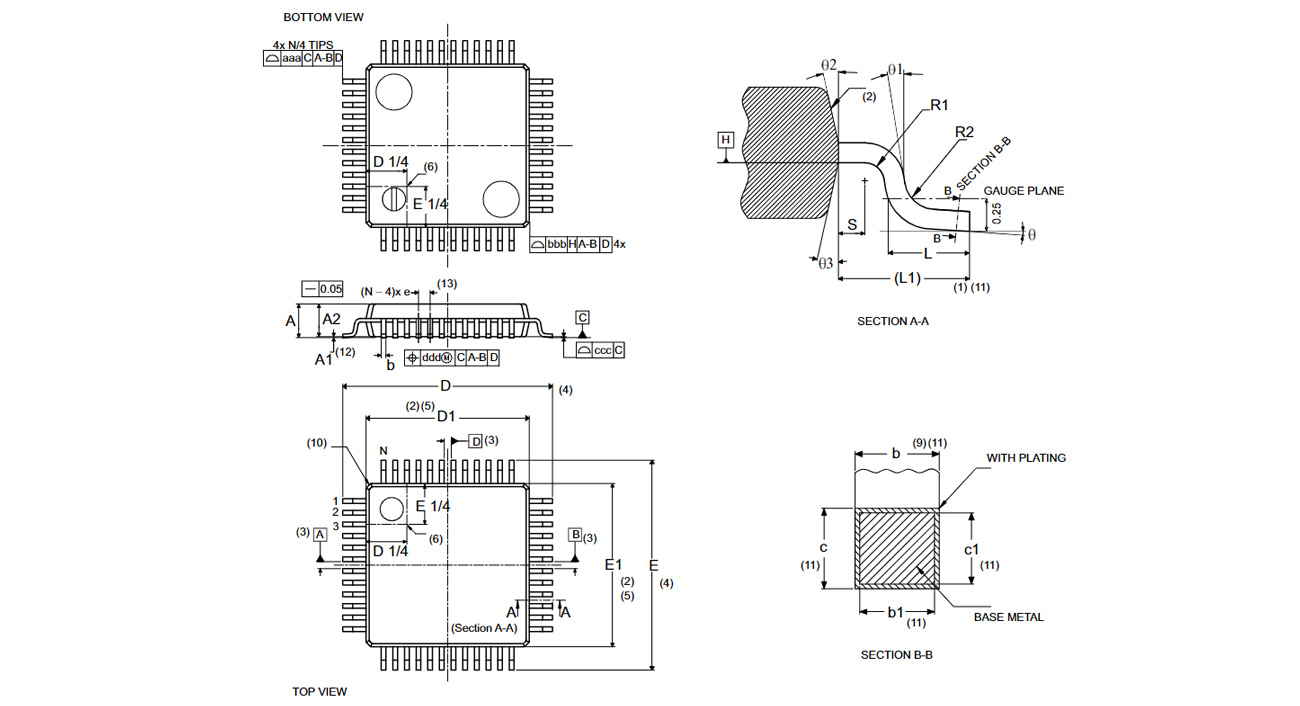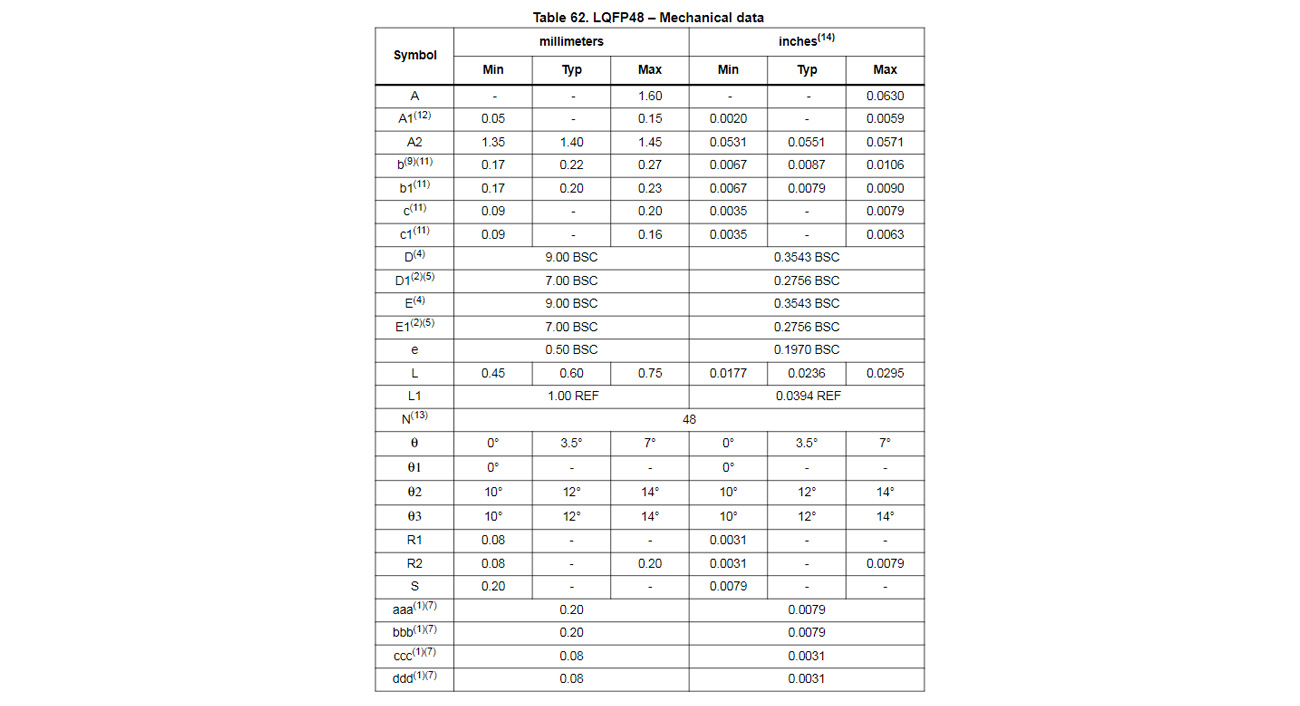Driven by intelligence and demand diversity, microcontrollers are currently indispensable electronic components in all walks of life. Usually when selecting, factors that need to be considered include: memory ROM/RAM, speed/clock frequency, peripherals, operating voltage, low-power design, packaging, etc. This article mainly introduces a cost-effective and performance-stable microcontroller - STM32F103C8T6.
STM32F103C8T6 Features
STM32F103C8T6 is a medium-density mainstream performance line MCU. It incorporates Arm® Cortex®-M3 32-bit RISC core operating at a 72 MHz frequency, and high-speed embedded memories. Package in 48-LQFP.
Arm® Cortex®-M3 is the MCU core of ARMv7 architecture launched by ARM. Based on this core, ST completed the design of peripheral circuits such as USART, DMA, and GPIO. STM32 MCUs developed with M series cores can be divided into low-power, mainstream, and high-performance lines.
The STM32F1 series are all based on the Cortex-M3 core but have different Flash sizes. STM32F103C8T6 comes with 64KB FLASH and 20K SRAM size.

Source from STMicroelectronics
With an extensive range of enhanced I/Os and peripherals connected to two APB buses. It offers two 12-bit ADCs, three general-purpose 16-bit timers plus one PWM timer. Besides, it integrates standard and advanced communication interfaces including two I2Cs and SPIs, three USARTs, a USB, and a CAN. It can easily meet a variety of application requirements.
This device operates from a 2.0 to 3.6V power supply. The temperature range is from –40 to +85°C.
STM32F103C8T6 supports a variety of development tools and programming languages, such as Keil, IAR, and GCC. Users can develop and program according to their own needs easily.
Low-power Modes
The low-power design allows it to feature multiple energy-saving modes to minimize power consumption and extend battery life. This makes it ideal for usage on mobile devices or applications that require long battery life.
It has an integrated power-on reset (POR)/power-down reset (PDR) circuitry. It is always active and ensures proper operation starting from/down to 2 V. The device remains in reset mode when VDD is below a specified threshold, VPOR/PDR, without the need for an external reset circuit.
The device features an embedded programmable voltage detector (PVD) that monitors the VDD/VDDA power supply and compares it to the VPVD threshold. An interrupt can be generated when VDD/VDDA drops below the VPVD threshold and/or when VDD/VDDA is higher than the VPVD threshold. The interrupt service routine can then generate a warning message and/or put the MCU into a safe state. The PVD is enabled by software.
STM32F103C8T6 supports three low-power modes to achieve the best compromise between low-power consumption, short startup time, and available wakeup sources.
Sleep Mode
In sleep mode, only the CPU is stopped. During operating, when the Cortex-M3 core encounters a WFE or WFI instruction, it will stop the internal clock and stop program execution. However, all peripherals continue to operate until a peripheral generates a time or interrupt, then the core will wake up and end over the sleep mode.This state will retain the core register and memory data before sleep.
Cortex-M3 adopts Tail-Chaining interrupt technology, which handles interrupts entirely based on hardware, which can reduce the number of clock cycles by up to 12. It can reduce interrupts by 70% in actual applications.
Stop Mode
The stop mode achieves the lowest power consumption while retaining the content of SRAM and registers.
The user sets the SLEEPDEEP bit in the power control register of the Cortex-M3 processor and then clears the PDDS bit in the power control register to complete the shutdown mode setting.
Based on the above setting, the CPU will stop working once it encounters a WFI or WFE instruction, and HSI and HSE will also enter a closed state. Flash and SRAM will continue to maintain the power supply, so the working states of ST32F103C8T6 are still retained.
In addition, stop mode can also be woken up by peripheral interrupts. However, in shutdown mode, except for the external interrupt control unit, the clocks of all devices are disabled. The STM32 can only be woken up from the shutdown state by triggering an external interrupt by generating a level edge on the GPIO pin.
The external interrupt channel is also connected to the alarm event of the Real-time clock (RTC). In addition, the counting clock of the RTC does not come from the device bus of STM32F103C8T6, but directly from LSI or LSE. Therefore, you can also use the RTC module to achieve regular wake-up.
In this state, all peripherals are stopped. However, the data of register and memory are retained due to some of the power still running.
However, due to the part of the power supply in the 1.2V area is not turned off, the content of the core register and memory is still retained. Therefore, after waking up from stop mode and restarting the clock, you can continue executing code from where you last stopped.
Standby Mode
The standby mode is used to achieve the lowest power consumption. The internal voltage regulator is switched off so that the entire 1.8V domain is powered off.
Sets the SLEEP bit in the power control register and the PDDS bit in STM32_PCR, the device will enter standby mode.
There are many ways to wake up, including the RTC alarm event, NRST external pin reset, reset signal generated by the independent watchdog (IWDG), and a rising edge generated on the PA0 pin (requires prior Set as wake-up pin function).
Different from the other two modes, when entering standby mode, all SRAM data and content of Cortex-M3 processor registers, and STM32F103C8T6 register will be cleared. It is equivalent to a hardware reset.
LQFP48 Package Information



Source From STM32F103C8T6 Datasheet
Applications
STM32F103C8T6 is a high-performance, low-power, programmable, and cost-effective MCU. It is widely used in industrial control, automotive, smart homes, electronic games, medical equipment, and other fields.
In terms of industrial control, this STM32 Microcontroller has high-speed computing and rich peripheral modules, which can support factory automation, intelligent manufacturing, robot control, etc.
The low power consumption design and high reliability make it an ideal control chip in automotive electronic equipment such as on-board electronic control units.
STM32F103C8T6 can be used as the core chip of the smart home system, responsible for collecting and processing various sensor data and performing corresponding control tasks. The high-precision ADC module and low-power design make it ideal for medical equipment such as portable blood glucose meters, thermometers, etc.
In electronic game applications, it can realize game logic control, audio and video processing, and drivers of various peripheral devices.
Conslusion
In conclusion, STM32F103C8T6 is functional and easy to use. With sufficient inventory on the market and competitive prices, it is a great choice for many product designers and developers.